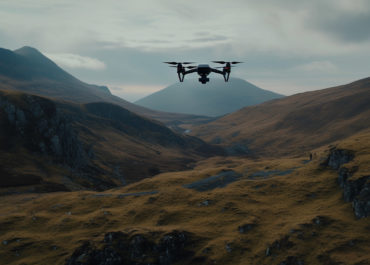Introduction
Artificial Intelligence (AI) has been making significant advancements in various industries, and one area where its impact is particularly notable is in the field of drones. Drones, also known as unmanned aerial vehicles (UAVs), have been revolutionizing industries such as agriculture, logistics, filmmaking, and surveillance. The integration of AI technologies with drones has further enhanced their capabilities, making them more intelligent, efficient, and versatile. In this article, we will explore the positive impact of AI on drones and how it is transforming the way we utilize these aerial vehicles.
The Role of AI in Drones
Enhancing Autonomy and Navigation
AI plays a crucial role in enabling drones to navigate autonomously and make intelligent decisions. Through the use of computer vision, machine learning, and deep learning algorithms, drones can perceive their surroundings, detect obstacles, and adapt their flight paths in real-time. This level of autonomy allows drones to perform complex tasks, such as mapping terrain, inspecting infrastructure, and conducting search and rescue operations, with minimal human intervention.
Improving Object Detection and Tracking
AI-powered drones are equipped with advanced computer vision systems that enable them to accurately detect and track objects of interest. These systems use sophisticated algorithms to analyze visual data captured by onboard cameras and sensors. This capability is particularly useful in applications such as wildlife monitoring, crowd surveillance, and disaster management, where drones can identify and track specific targets or anomalies in real-time.
Enabling Intelligent Data Analysis
The integration of AI with drones allows for intelligent data analysis on the fly. Drones equipped with AI algorithms can process vast amounts of data collected from various sensors, cameras, and other sources in real-time. This enables them to extract valuable insights, identify patterns, and make informed decisions. For example, in casino siteleri agriculture, AI-powered drones can analyze crop health data and provide farmers with actionable recommendations for optimizing irrigation, fertilization, and pest control.
Facilitating Swarm Intelligence
AI algorithms have also been instrumental in enabling swarm intelligence among drones. Swarm intelligence refers to the collective behavior of a group of drones that work together towards a common goal, mimicking the behavior of a swarm of bees or a flock of birds. AI algorithms enable drones to communicate, coordinate, and collaborate effectively, allowing them to accomplish complex tasks more efficiently. Swarm intelligence has applications in areas such as surveillance, search and rescue operations, and even package delivery.
Applications of AI in Drones
Agriculture and Crop Monitoring
AI-powered drones are transforming the agriculture industry by enabling efficient crop monitoring and management. Drones equipped with AI algorithms can capture high-resolution aerial images of fields and analyze them to detect crop health issues, identify nutrient deficiencies, and even predict yield. This allows farmers to make data-driven decisions, optimize resource allocation, and maximize crop productivity.
Infrastructure Inspection and Maintenance
AI-powered drones are being used for efficient and cost-effective infrastructure inspection and maintenance. Drones equipped with AI algorithms can autonomously inspect bridges, power lines, pipelines, and other critical infrastructure. They can detect structural defects, identify areas of concern, and generate detailed reports, enabling timely maintenance and reducing the risk of accidents or failures.
Disaster Response and Relief Operations
AI-powered drones are playing a crucial role in disaster response and relief operations. Drones equipped with AI algorithms can quickly survey disaster-stricken areas, assess damage, and identify areas where immediate help is required. They can also help in search and rescue operations by autonomously searching for survivors in inaccessible or hazardous locations. The use of AI-powered drones in disaster response can significantly improve the efficiency and effectiveness of relief efforts, ultimately saving lives.
Filmmaking and Aerial Photography
AI-powered drones have revolutionized the field of filmmaking and aerial photography. Drones equipped with AI algorithms can capture stunning aerial shots with precision and stability. They can autonomously follow a subject, track their movements, and capture cinematic footage. This has opened up new possibilities for filmmakers, photographers, and content creators, allowing them to capture breathtaking visuals from unique perspectives.
Challenges and Future Opportunities
While the integration of AI with drones has brought about significant advancements, there are still challenges that need to be addressed. These include regulatory concerns, privacy issues, and the need for robust and explainable AI algorithms. However, with ongoing research and development, the future of AI-powered drones looks promising.
In the future, we can expect to see even more intelligent and autonomous drones that can perform complex tasks with greater efficiency and accuracy. The combination of AI, drones, and other emerging technologies such as 5G, Internet of Things (IoT), and edge computing will further expand the capabilities of drones and enable innovative applications in areas such as delivery services, urban air mobility, and environmental monitoring.
Conclusion
AI has revolutionized the capabilities of drones, making them more intelligent, autonomous, and versatile. From agriculture and infrastructure inspection to disaster response and filmmaking, AI-powered drones are transforming various industries and enabling us to accomplish tasks more efficiently and effectively. As technologycontinues to advance, we can expect to see even more exciting applications and opportunities for AI-powered drones in the future. The positive impact of AI on drones is undeniable, and it is an exciting time to witness the evolution of these aerial vehicles as they revolutionize industries and change the way we interact with the world.
